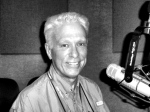The only true voyage… would be not to visit strange lands but to possess other eyes, to see universe through the eyes of another, of a hundred others, to see the hundred universes that each of them sees, that each of them is. – Marcel Proust
I recently read a fascinating book by Alexandra Horowitz, On Looking: 11 Walks with Expert Eyes.
In each chapter Horowitz takes a walk around her Manhattan block or in other neighborhoods with different experts to understand what they see that escapes Horowitz/s conscious awareness. She walks with a geologists, a biologist, a researcher in pedestrian behavior, a sound technician, skilled medical diagnosticians, and so on.
Each walk revealed to Horowitz a world that was previously invisible to her and provided experiences through which she believes she will be forever changed.
Horowitz writes: “There is a certain bias in everyone’s perspective that has been named, by the French, deformation professionnelle: the tendency to look at every context from the point of view of one’s profession.”
What do expert teachers and principals see that I would not?
As I read the book I found myself wondering what expert teachers and principals see each day in their classrooms and schools that would be invisible to me. A great deal, I suspect.
But my experience in spending time with such educators has revealed that they are often not as skillful as Horowitz’s experts in explaining what they observe and what it means.
While accomplished teachers and principals see patterns and details that escape my notice, they may or may not be able to explain it in the complex and nuanced way that, say, an expert on pedestrian behavior offered his running commentary to Horowitz as they strolled down a Manhattan street.
Here are two fundamental reasons why I think that’s true:
• Teachers’ and principals’ expertise has not been acknowledged and appreciated within and beyond the school community. As a result, they might think that everyone sees what they see and does what they do. These teachers and principals often find it hard to imagine that not everyone thinks and acts as they do.
• They have had few opportunities to polish that expertise by sharing it with others.
Such fine-tuning and collegiality benefit both the individual teacher or administrator and the broader school community and are hallmarks of outstanding schools.
The continuous improvement of teaching and learning for the benefit of all students requires that accomplished teachers and principals share their expertise — which begins with what they are observing and thinking.
Three things are required to develop and tap that expertise:
1. Developing expertise through experience and reflection on the effects of one’s practice on student learning and other valued outcomes. Years of such practice are essential. (10,000 hours is an oft-cited number of hours required to develop expertise.)
2. Honing one’s descriptive abilities through conversation such as those that occur in team meetings and writing in journals and blogs.
3. Sharing that expertise within a culture of continuous improvement. (Creating such a culture, I believe, belongs among the highest priorities of principals and teacher leaders.)
I encouraged teacher leaders and principals who wish to take their performance to another level to invite others into their classrooms and schools and to explain to them in close to real-time what is observed and the thought processes behind the countless management and instructional decisions made during a particular lesson or throughout the day.
Effective instructional coaches and principals, of course, enable such mindful professional learning processes.
Horowitz concludes, “An expert can only indicate what she sees; it is up to your own head to tune your senses and your brain to see it. Once you catch that melody, and keep humming, you are forever changed.”

You need to be a member of School Leadership 2.0 to add comments!
Join School Leadership 2.0